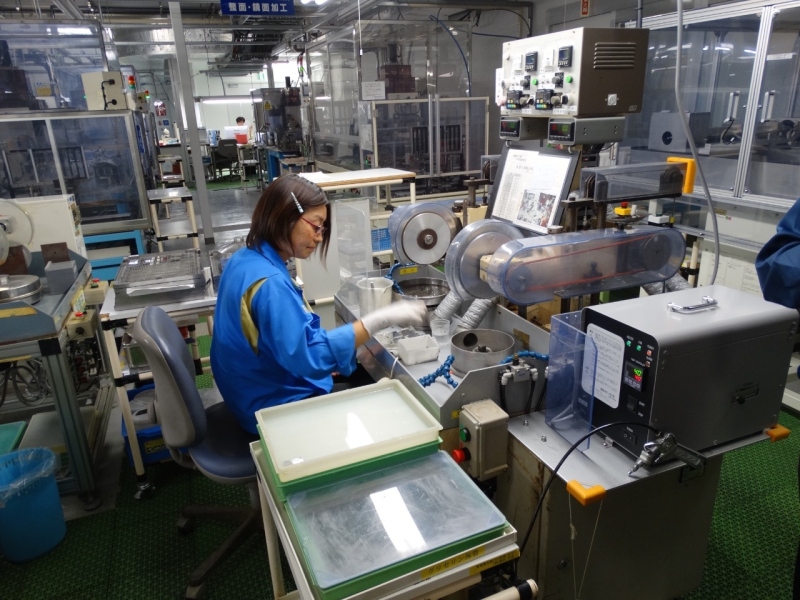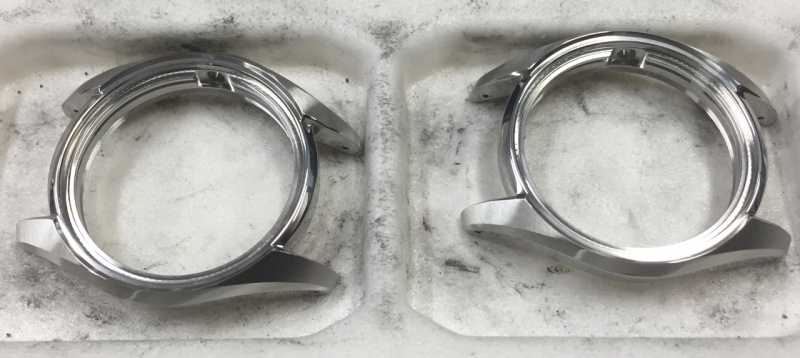
cazalea
[Seiko Moderator]
17048

VISIT TO SEIKO PART 2: Component Manufacturing
Thanks for reading Part 1 of this series.
After thinking a long time about strategy, I have decided to divide my report into segments based on the theory of production and movement type, rather than strictly by the factory visited.
This is the dial production area. These brass-then-silver-plated dial blanks are being given a sunburst treatment, done by wire wheel brushing underneath a gray slurry.

The wire wheel only lasts a day or so.

Restriction plates are fitted to allow an inch or so to protrude and do the brushing. After a few sets of dials the bristles are worn away, and a smaller plate is fitted to carry on - until the whole wheel has disappeared into the slurry.

End result is this very finely brushed dial base, after which holes are drilled, printing is done, markers are applied, etc.

Here's the dial printing, using a rubber "tampon" as the French would say. Seiko even formulates their own rubber mix and molds these ink applicators.

The result of this particular process is the words Grand Seiko and the power reserve curve appearing on this Spring Drive dial.

As you might expect, they make hands, too. Curved second hands fit Galante models. Some watches get Lumibrite, a luminous material that Seiko patented and produces, of course.

Here he is setting the second hand's center (the tiny part that grips the arbor) into the hand itself. It is done by tapping a lever on his press with a tiny hammer, while a huge weight absorbs any shock.

This gentleman is diamond-cutting the markers for dials - there are 7 facets to reflect as much light as possible:

Then those markers get plated and combined with other decoration, and inserted into holes in the dial. The hour marker legs are 0.2mm while the holes are just .021mm diameter. How hard would it be to insert those markers?

Then the quality control inspection! Counting 1, 2, 3, 4, etc.

Cases are produced by either forging or CNC machining. They have some proprietary processes to do this, and we didn't take any pictures of the huge room and its contents.



I hope you will come on back for Part 3
This message has been edited by cazalea on 2014-10-19 20:21:32 This message has been edited by cazalea on 2014-10-21 05:44:08
Seiko relies on various small component specialists to supply it with parts for its movements. Unlike many Swiss manufactures, Seiko tends to own those companies. So with the exception of things like straps and packaging, Seiko gets almost everything "from itself" which has some great advantages in production planning, transfer costs, etc.
The two facilities we visited each employ about 600 people. They have lots of industrial machinery as well as craft studios - mixtures of brazing torches and huge stamping presses, diamond setting and GPS satellite emulation systems, mainspring production and crystal "growing", ceramic dial firing and 10-million-a-month robot assembly lines. Almost all parts are made there, or are available from "in-house" suppliers.
For example, quartz crystals come from Epson Atmix, in Aomoi prefecture. Strategy and design of the watch and its software is done in the Shiojiri factory, programming of the chips are a collaboration between the watch and semiconductor groups, and actual production is done in another factory. But all "in our big collective house".
Let's begin the tour:
This is the dial production area. These brass-then-silver-plated dial blanks are being given a sunburst treatment, done by wire wheel brushing underneath a gray slurry.

The wire wheel only lasts a day or so.

Restriction plates are fitted to allow an inch or so to protrude and do the brushing. After a few sets of dials the bristles are worn away, and a smaller plate is fitted to carry on - until the whole wheel has disappeared into the slurry.

End result is this very finely brushed dial base, after which holes are drilled, printing is done, markers are applied, etc.

Here's the dial printing, using a rubber "tampon" as the French would say. Seiko even formulates their own rubber mix and molds these ink applicators.

The result of this particular process is the words Grand Seiko and the power reserve curve appearing on this Spring Drive dial.

As you might expect, they make hands, too. Curved second hands fit Galante models. Some watches get Lumibrite, a luminous material that Seiko patented and produces, of course.

Here he is setting the second hand's center (the tiny part that grips the arbor) into the hand itself. It is done by tapping a lever on his press with a tiny hammer, while a huge weight absorbs any shock.

This machine is set up for polishing the leaves (gear teeth) on a pinion before assembly it with its gear. The watchmakers among us can testify to how tiny this item is - the rest of us can look at the tray at far right that seems to have ants in it. The camera shows a greatly magnified view so we can see how the product looks.


This gentleman is diamond-cutting the markers for dials - there are 7 facets to reflect as much light as possible:

Then those markers get plated and combined with other decoration, and inserted into holes in the dial. The hour marker legs are 0.2mm while the holes are just .021mm diameter. How hard would it be to insert those markers?

Then the quality control inspection! Counting 1, 2, 3, 4, etc.

Cases are produced by either forging or CNC machining. They have some proprietary processes to do this, and we didn't take any pictures of the huge room and its contents.
Here are some cases though.

We did watch the polishing, brushing and cleaning. Here are more finished cases, after cleaning they are drying on a rack.

Many of the individual machines in the case room had bubble levels on them - a residual effect of tsunami, earthquakes, etc. They want to be sure things are on the level.


In between these component-making rooms were giant spaces filled with assembly lines of robots that make up to 8-10 million entry-level watches a month. I get the impression that those activities are a great help in developing a cadre of folks looking to move into the more exotic studios and prestige jobs.
So that's about it for component manufacturing. We didn't spend much time on the other areas such as screw making, stamping dial spacers, molding plastic, etc. but trust me when I say these are by far the most comprehensive facilities for manufacturing that I've ever seen. And quite clean, as you can imagine.

I hope you will come on back for Part 3
More posts:

VISIT TO SEIKO PART 2: Component Manufacturing
Thanks for reading Part 1 of this series. After thinking a long time about strategy, I have decided to divide my report into segments based on the theory of production and movement type, rather than strictly by the factory visited. Seiko relies on various...

Very detailed report....
.. and very so nice of you to show you all this! Now we know how hard they work by themselves to make things "better". Keep them coming! Getting very interesting! Ken


Fascinating...and a must read for anyone truly interested in watchmaking...
And not just the marketing prestige frou frou... I just visited Cadran Fluckiger, the dial maker for Patek Philippe. i see some similar processes and equipment! Thanks, looking forward to the rest of the series...
